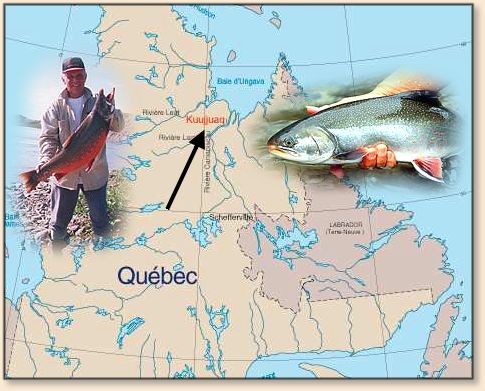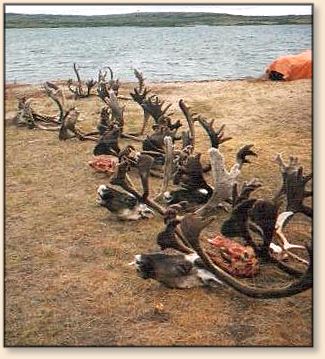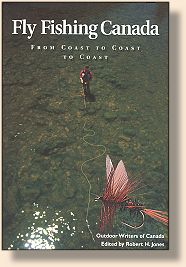|
The words arctic char bring to mind a river - swift,
cold, rock-strewn - a background of 15' (4.5-m) black
spruce, and beyond, a range of low mountain. This is
what John and I encountered when we arrived at Kanniq
(Helen's Falls) on the famous George River, intent on
fishing for Atlantic salmon.

Like most fly-ins, our starting point was Kuujjaq
(formerly Fort Chimo). [Northern Quebec] The flight
eastward, 60 miles (97 km) or so, terminated on a
small landing strip near the camp. We were thankful
our pilot knew what he was looking for, as the terrain
all looked the same to us.
Weather in the Far North is always a consideration,
especially in the last part of the season. Fishing
trips to these types of camps are usually of seven
day's duration, which allows for weather changes and
variations in fishing conditions. Caribou are migrating
as the salmon and char fishing draws to a chose, so it
is common to find hunters and anglers in the camp at
the same time. If so inclined, you can book a combination
trip, fishing and hunting on alternate days. In fact,
when you arrive back in Kuujjuaq, it's common to see
large piles of caribou antlers sitting on the tarmac,
waiting to be loaded along with the hunters and anglers.

In our case, the weather was cooperative, and after
the river had yielded some fine salmon, we decided to
spend one day on our own to try for arctic char. They
are something of a mystery. Of the same family as brook
trout and lake trout, arctic char have the same need
for pure, cold water, but unlike their relatives seem
to be found mostly in rivers. Anglers often become
frustrated with them, especially when nothing seems
to work - which can probably be attributed to the fact
that we seldom devote much time to them, preferring to
pursue Atlantic salmon, which after all, is what attracts
us up there in the first place.
Excellent fishing for char of 8-10 lb (4-5 kg) is found
in many rivers flowing north into Ungava Bay. Commercial
camps located on rivers like the Payne, Tumulik and George
usually concentrate on salmon throughout the short summer.
However, some also offer char fishing and in a few cases
brookies and lake trout.
Initially, our quest proved easier said than done, for
the char were definitely not where our guides had said
they should be - about 2 miles (3 km) downstream from
camp. Puzzled, we pressed on.
Our perseverance paid off, for 1 mile (1.6 km) farther
downstream we found the hot spot. It lay right in the
main river - a fairly fast, even flow, roughly 3' (90 cm)
deep over a gravel bottom.
At our guide's insistence we had taken spinning tackle,
which is legal there for char, but the heavy lures
produced frequent hang-ups. It was obvious that fly
tackle would be more effective, so we switched to our
light salmon outfits - a prudent move that led to a
memorable day of fishing.
I have heard that arctic char on some rivers may make
extended runs, perhaps right into the backing, even
punctuating them occasionally with a jump when the
run ends. I have never seen this on the George River.
Unlike salmon, which dissipate their strength with
long runs and repeated jumps, a char's fight is more
remindful of a large, dogged, brook trout. I suppose
it's possible that this particular strain is unable
to jump, for except when they are on their spawning
run, we tend to find them in calmer stretches of the
river and never below the falls or rapids where
salmon congregate.
Medium-weight tackle is recommended. My favorite char
rod is a 10' 7/8 weight that easily throws large No.
8-2 streamers. Almost invariably you will find yourself
in situations that call for casting a fair distance into
a strong wind, which is, of course, probably what you
were doing all along while salmon fishing.
Char have no experience with fly hatches; consequently,
until they run upstream their only food will have been
creatures like capelin and shrimp. Flies are usually
bright and flashy - red and white or blue and white - with
a silver tinsel body. I originally decided on using a
blue and white streamer since it resembled a Blue Fox
spoon that the Inuit were using successfully with their
spinning tackle.

After John and I tired of fishing, we poked around and
eventually found ourselves looking down a 10 char busily
performing all the gyrations associated with spawning.
We were dangling a large fly just over their heads,
unsuccessfully, when they all disappeared in a flash.
As we wondered what had happened, a lake trout, fully
five feet long, cruised slowly through the pool. It
wouldn't take our fly, either. However, it was a good
note on which to end our day and walk back to camp.
Incidentally, if you intend to save some char to take
home, we found the plainly hued ones were the best choice.
Those in full spawning regalia were quite soft and
unsuitable for the table. ~ Ken Robins
Credits: From Fly Fishing Canada, From Coast to Coast to Coast,
By Outdoor Writers of Canada, Published by Johnson Gorman Publishers.
We appreciate use permission!
|





